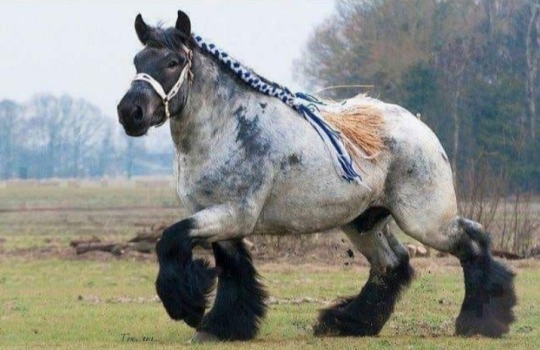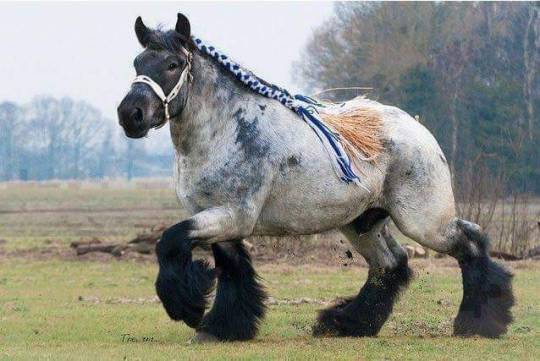#Solutré horse
Explore tagged Tumblr posts
Text

The Ardennes Draft Horse or Ardennais is considered one of the oldest breeds of draft horse.
Their history reaches back to Ancient Rome. The Ardennes breed could be a direct descendant of the prehistoric Solutré horse.
It is claimed to be descended from the type of horse described by Julius Caesar in his Commentarii de Bello Gallico.
Caesar described these horses of Belgium as "rustic, hard and tireless." He recommended them for use in heavy cavalry units.
The early type was used by many later Roman emperors for military applications.
The breed's ancestors are thought to have been bred for 2,000 years on the Ardennes plains. It is one of the oldest documented European heavy draft breeds.
They weigh 700 to 1,000 kilograms (1,500 to 2,200 lbs).
#Ardennes Draft Horse#Ardennais#draft horse#Ardennes breed#Solutré horse#Ancient Rome#Julius Caesar#Commentarii de Bello Gallico#Ardennes plains#European heavy draft breeds#horses#animals#horse breeds#Ardennes#war horses
46 notes
·
View notes
Text
Okay, horse magma story time
This summer i was on vacation and i visited the Rock of Solutré (France). It's a very pretty rocky formation in the middle of the grapevines of Bourgogne, pictured here:

it is a pretty sight, however that's only part of why it's well-known. This is a big site for prehistoric archeology, and a very old one: they were already digging stuff up in the 19th century.
There's been human activity around the site since around 55000 years ago, and a lot of traces of it. Back then, this was a hunting site, and they mainly hunted horses. A lot of horse remains were found at the foot of the rock, so a common myth is that the hunters drove the horses off the cliff to kill them. In reality, they most likely cornered the horses against the rocks before killing them.
Over the course of a few millenia they hunted a lot of horses.
Like, a lot.
Around this rock alone, the amount of horse remains found is upwards of 30 thousand.
Turns out, the carcasses were never really moved, and just slowly sunk into the ground, resulting in cubic meters upon cubic meters of horse bones densely mixed in with soil, making a mineral abomination that looks like this:

And you wanna know what it's called?
Horse magma.
Let me repeat.
Horse. Magma.
i am completely obsessed with this term. horse magma. magma of horse.
that will be all. may the horse magma have mercy on us
one of these days i should explain what the horse magma is
4 notes
·
View notes
Photo

Camargue horses - photo by Marco Carmassi.
The Camargue horses of France are one of the world’s oldest free-roaming populations. Their origins are not known, although there are many theories. Some believe that they descend from Roman stock, while others think that they are the descendents of the prehistoric Solutré horses.
The grey color of these horses is something that has thrown off evolutionary biologists for years. The Camargue delta is hot and sunny, and this coloration makes the horses more prone to melanomas. At first glance, it would seem that weeding out these delicate-skinned grey horses would make the most evolutionary sense. And yet, grey is the only color Camargues come in.
After hypotheses that grey horses escaped predators more easily and kept cooler by reflecting more sunlight were disproved, Hungarian researcher Gabor Horvath and his colleagues finally found the answer: flies. Horseflies are prevalent throughout the delta. They carry infectious diseases, and in massive quantities can suck so much blood from the horses that they become ill.
Grey horses like the Camargues have the advantage when it comes to being bitten less because Horseflies target their prey by following polarized light, where photons oscillate in the same direction rather than bouncing everywhere. Lighter hairs polarize light less efficiently than darker hairs, so the signal the Horseflies are looking for is weaker. White colored hair polarizes almost no light at all. Therefore, the whiter its base coat, the less a horse gets attacked.
Feral horses in other regions of the world can avoid horseflies in other ways - they can graze in drier areas, they can go where it is windy, or they can go where it is cooler. But in the Camargue, none of these are options, so having a grey coat color is a greater advantage to horses there than anywhere else.
For more information read The Horse: The Epic History of Our Noble Companion by Wendy Williams.
142 notes
·
View notes
Text
Tuesday 18 June. La Roche de Solutré et Paray Le Monial
Hot day forecast and we drove west to the Rock of Solutré early. At 9 am we were the only people on the 2.5 km trail to the top. Solutré is a limestone ridge, very distinctive in the landscape - the poet Lamartine called it a ‘petrified ship’.
It was once thought that palaeolithic men brandishing fire sticks, drove horse, deer, mammoth and bison over the cliff, to their death. Archaeology in the prehistory museum puts paid to the myth. The animals, mostly horse and deer were hunted in the valley and butchered at a site near the rock - too far away to have fallen to their death and the bones showed no signs of fracture from a fall. I have to admit I believed the myth and climbed to the top trying to imagine the terror of the animals being driven to their death. I had to readjust my thinking after the museum visit.
A group of ponies, grey with a black stripe from mane to tail, grazed the slopes of the rock. They are Konik Polski (little Polish) and thought to be related to the now extinct Tarpan horses that once roamed the valley.
There was a 360 degree view from the top of the rock - vineyards of the Maconais where the Chardonnay grape is grown and the famous Pouilly and Fuisée wines are made. There is a lot of activity at present - with so much rain, the vines have shot up and are being pruned back.
We drove further west to Paray le Monial where there is an abbey built soon after, and in imitation of the one at Cluny but completely intact. Our host, Claire, told us that the town is a centre for monks and nuns. The abbey, the chapel of apparitions, the stone buildings, rose gardens and flower-lined canal were all beautiful but not greatly interesting. However, we were intrigued by the game of Paradienne being played in the park - like petanque but the boules and cochonnet were bigger and the rules and style of play a bit different.
0 notes
Photo
Yes, Ardennes Draft Horses are gorgeous. But do you know the legend of the Solutré horse? This legend is very famous in my area. Solutré is a one hour drive away from where I live and there is this big rock amidst the vineyards (there is also another rock called "Vergisseron" but the Rock of Solutré is the cool one):

You can see some people on the top:

The Rock of Solutré is an important prehistorical site which was inhabited by men (the Solutrean) in the Upper Paleolithic.
In the 19th century, Adrien Acelin and Henry Testo-Ferry (both geoglists and archaeologists) has discovered thousands of horse, bison, auroch and mammoth bones at the foot of the rock and other stone artefacts: it’s one of the the most richest paleolithic remains site in Europe. In the 1870s, Adrien Acelin wrote a prehistoric novel about The Solutrean (”Solutré ou les chasseurs de rennes de la France centrale”) and created a myth on the horse hunting: the Solutrean hunted them by driven them off the rock:

The hunt in the abyss myth has long been considered a historical fact. Although the Solutrean hunted the horse for hides and meat, there is no trace of a fall on the bones.
Also, if you visit the site you will see Konik Polki horses, a crossbred descendant of the wild horse (personal photo):

(sorry for my English mistakes!)

The Ardennes Draft Horse is considered one of the oldest breeds of draft horse, and is believed to be a direct descendent of the prehistoric Solutre Horse.
Via Historical Pictures
61K notes
·
View notes